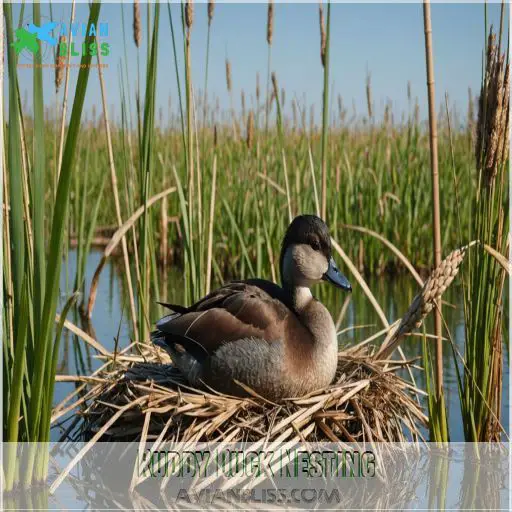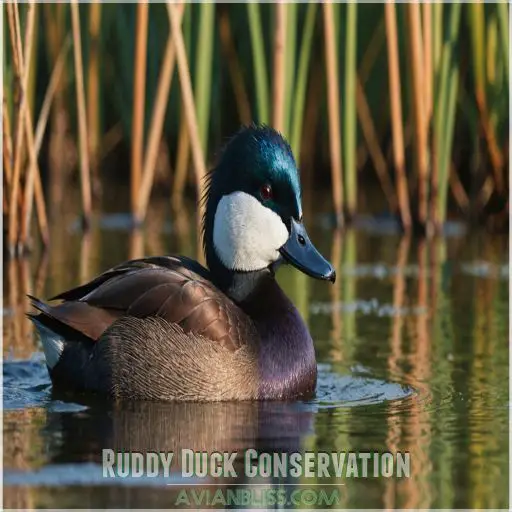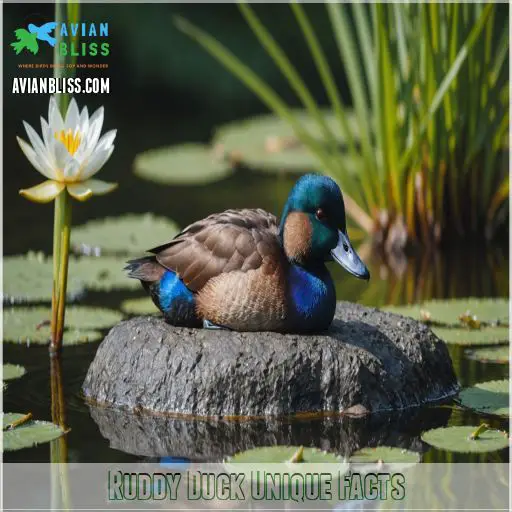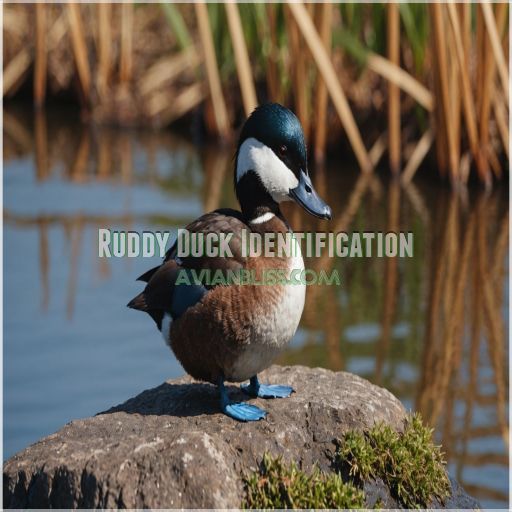This site is supported by our readers. We may earn a commission, at no cost to you, if you purchase through links.

Females keep it subtle with a gray-brown hue and a chic dark cheek line.
These compact, crow-sized waterfowl gracefully patter across water surfaces before flying at modest heights.
Found in wetlands, they feast on insects and plants, adjusting seasonally for a balanced diet.
These plucky ducks have their share of struggles, facing threats from habitat loss and climate change.
Curious for more intriguing facts?
Table Of Contents
- Key Takeaways
- Ruddy Duck Appearance
- Ruddy Duck Behavior
- Ruddy Duck Habitat
- Ruddy Duck Diet
- Ruddy Duck Nesting
- Ruddy Duck Reproduction
- Ruddy Duck Conservation
- Ruddy Duck Unique Facts
- Ruddy Duck Migration
- Ruddy Duck Identification
- Frequently Asked Questions (FAQs)
- Why do Ruddy ducks have blue bills?
- Why is it called Ruddy Duck?
- Why are ruddy ducks invasive?
- What is a fun fact about ruddy ducks?
- How does the Ruddy Ducks social structure function?
- What sounds do Ruddy Ducks make during courtship?
- How do Ruddy Ducks interact with other species?
- What is the lifespan of Ruddy Ducks in the wild?
- How does seasonal change affect Ruddy Duck behavior?
- Conclusion
Key Takeaways
- You’ll easily spot a ruddy duck with its flashy bright blue bill and fierce, spiky tail pointing skyward like it’s challenging gravity. During breeding season, the males strut around in standout chestnut plumage, making them the supermodels of the duck world.
- These ducks aren’t just about looks; they’re interesting folks too! Males perform a splashy show during courtship, complete with head bobs and bill clicks. It’s like a romantic dance-off to win over the lady ducks!
- Ruddy ducks have culinary adventures at the pond buffet, enjoying a diverse omnivorous diet. They dive for tasty treats like insects and aquatic plants, adjusting their menu with the seasons. They’re the foodies of the waterfowl community!
- Despite their quirks and charm, ruddy ducks face the harsh realities of habitat loss and climate change. They’re like eco-warriors in need of a safe swampy sanctuary, reminding us of the importance of conserving their wetland habitats.
Ruddy Duck Appearance
When spotting a Ruddy Duck, look for males flaunting vibrant chestnut plumage and bright blue bills in the breeding season, while donning a more subdued gray-brown in the off-season.
Females may sport pale cheeks with a distinctive dark line, looking a bit like they borrowed some eyeliner.
Breeding Season Characteristics
During the breeding season, male Ruddy Ducks strut dazzling looks with their dark cap, white cheeks, and ruddy brown body.
Their bright blue bill feels like nature’s shock of blue, catching everyone’s eye.
Females, not to be left out, sport pale cheeks with a charming dark line, like mascara for ducks!
This courtship ritual charms potential mates across wetland breeding grounds during mating.
Non-Breeding Season Characteristics
During the fall and winter months, male Ruddy Ducks trade their vibrant chestnut plumage for a more subdued gray-brown look.
Their bright blue bill also fades, blending in with their duller colors.
Females maintain their mottled gray-brown hues year-round.
Both sexes gather in flocks on coastal waters, foraging and resting together until spring’s return.
Size and Shape
As you’re observing the Ruddy Duck, its compact size and shape will catch your eye.
These stiff-tailed ducks share crow-like proportions, packing a punch with their chunky bodies and bold head shape.
Picture a masked duck’s cousin with a unique blue bill.
At 15 inches long, with an 18.5-inch wingspan, they’re compact but unmistakably memorable.
Distinctive Features
Identifying ruddy ducks, or oxyura jamaicensis, is a breeze.
Spot their distinctive features:
- The clownish bright blue bill (it’s unmistakable).
- A spiky tail that often points skyward like it’s challenging gravity.
- Crisp white cheeks that scream contrast.
- In North America, especially Central Canada, the chestnut plumage is perfect for adding a splash of ruddy color to wetlands.
Plumage Colors and Patterns
When checking out Ruddy Ducks, you’re in for a colorful treat! During the breeding season, males flaunt rich chestnut bodies and bright blue bills. In contrast, females rock more subdued gray-brown tones.
The changes in their plumage work like nature’s camouflage. Here’s a quick peek:
| Duck Stage | Male Color | Female Color |
|---|---|---|
| Breeding | Chestnut | Gray-brown |
| Non-breeding | Gray-brown | Gray-brown |
| Molting | Mixed hues | Subtle tones |
Marvel at how these colors, like wild celery and aquatic grass, evolve through the seasons!
Ruddy Duck Behavior
Ruddy ducks are quite the characters, with their quirky behaviors and unique vocalizations.
From their rapid wing beats in flight to their distinctive courtship displays, these diving ducks have plenty of fascinating traits to observe.
Flight Patterns
Ruddy Ducks have a unique takeoff technique, pattering across water before taking to the skies with their sturdy wingspan.
They fly at moderate speeds, usually not winning any duck-air-races, and maintain a low altitude.
You might spot them above wetlands in the western USA or near the Great Lakes, gracefully dodging human interaction while pondering their next meal of caddisfly larvae.
Migration Habits
The Ruddy Duck’s migration habits can seem as mysterious as a magician’s trick.
Traveling mostly at night, these ducks prefer small flocks for their journeys.
Migration timing stretches through spring and fall, with each duck tracing migration routes over thousands of miles.
These ducks aren’t in a rush, savoring the journey as they venture between distant waters.
Social Interactions
In the fascinating world of ruddy ducks, social interactions are quite the spectacle.
These ducks often keep to themselves but can form small, tight-knit flocks for migration.
While they prefer flying solo, they’re not shy about engaging in territorial disputes.
Through various communication methods, including playful quacks and subtle signals, these ducks balance group dynamics with their independent streak.
Courtship Displays
During courtship, male Ruddy Ducks put on quite a show!
They’ll bob their heads, click their bills, raise their tails, flutter their wings, and even splash around in the water – all to impress potential mates.
It’s a lively dance that’s sure to catch your eye and leave you captivated by these charismatic waterfowl.
Vocalizations
Courtship calls aren’t all Ruddy Ducks have in their acoustic arsenal. They’ve quite a few tricks up their sleeves when it comes to vocalizations:
- Distinctive sounds emerge softly from males.
- Song variations occur during courtship displays.
- Sound communication involves staccato songs and nasal squeals.
- Vocalizations purpose lies in attracting mates and defining territory.
These feathered crooners keep things interesting!
Ruddy Duck Habitat
You’ll find Ruddy Ducks setting up home in rich wetlands, from the marshy ponds of Canada to sheltered bays along the U.S. coast during winter.
They prefer spots with dense aquatic plants, giving them the perfect hideout from nosy predators and a buffet of tasty treats.
Breeding Grounds
Picture Ruddy Ducks as discerning interior designers, selecting breeding grounds with dense marsh vegetation to fashion their grassy, concealed nests.
They settle mainly in the marshy ponds and lakes across south-central Canada and the north-central United States.
However, habitat threats like climate change and human disruptions can throw a wrench in their breeding success and population density.
Conservation efforts are key.
Wintering Grounds
In winter, Ruddy Ducks flock to sheltered bays, estuaries, and coastal marshes. You’ll often spot them bobbing on the water’s surface, taking refuge from the chilly winds.
Their preferred wintering grounds offer:
- Protected, shallow waters
- Abundant aquatic vegetation
- Plentiful food sources like mollusks and crustaceans
- Fewer predators than their breeding grounds
These cozy havens allow Ruddy Ducks to conserve energy and prepare for the journey back to their northern nesting sites.
Preferred Wetland Types
It’s winter, and you’re a Ruddy Duck seeking the perfect wetland. Go for spots with variable depth and good water quality.
Dense vegetation provides a natural shield from predators. Stay clear of areas buzzing with human activity.
These watery hideaways promise a cozy nook for mingling and munching, giving you a quacking good life!
Aquatic and Lakeside Vegetation
Ruddy Ducks’ housing market is all about location. When they’re choosing their digs, they love aquatic and lakeside vegetation for:
- Nesting habitat: Dense vegetation keeps their nests safe and sound.
- Food sources: It’s a buffet with seeds and insects.
- Predator protection: Think of it as their leafy fortress.
- Species diversity: They enjoy sharing the neighborhood with other wildlife.
Ruddy Duck Diet
You’ll find the Ruddy Duck’s dining choices as varied as a buffet, feasting on everything from seeds to insects while foraging underwater with a spatula-shaped bill.
With an omnivorous appetite, this duck switches to more plant-based meals during winter, showcasing its adaptability to seasonal changes.
Foraging Methods
You’ll be amazed by how Ruddy Ducks forage! They dive underwater with wings tucked tight, sifting through mud with their specialized bills to find tasty morsels.
When feeding near the surface, they skim tiny insects right off the top.
Their foraging techniques shift with the seasons to match their changing dietary needs.
Food Sources
Picture a tiny speckled forager diving with flair.
Ruddy Ducks dive into aquatic worlds, snacking on midge larvae and crustaceans when they’re in season—nature’s granola bars!
Try not to envy their buffet; their foraging techniques are a splashy dance.
Seasonal diet shifts happen as predator impact and habitat alterations influence food availability, making every meal an adventure in survival.
Omnivorous Diet
Imagine you’re a Ruddy Duck, a connoisseur of mud-sifting, with a menu that includes aquatic plants and insects.
Your bill acts like a sieve, filtering out tasty treats like beetle larvae and grass seeds, a tasty and nutritious treat.
You’re omnivorous, enjoying a buffet of food preferences.
With each dive, you fill your belly, balancing insect consumption and aquatic nourishment, embracing life’s seasonal variations.
Seasonal Dietary Changes
Ruddy Ducks shift their diet based on food availability. Insect abundance fuels energy-hungry ducklings during breeding, while adults feast on bugs like kids on candy.
As seasons change, their menu turns greener to help them survive the winter and gather fuel for migration. Here’s the menu twist:
- Summer: Loads of larvae.
- Autumn: Salad time.
- Winter: Seeds and roots.
Ruddy Duck Nesting
As for nesting, Ruddy Ducks are quite the crafty builders.
They construct their platform nests using a woven mix of grasses, cattails, and even old muskrat houses – all hidden away in the dense marsh vegetation.
Nest Construction
Crafting their nest is like building a hidden fortress for Ruddy Ducks.
They choose safe, sheltered locations to outwit predators, weaving an intricate nest with precision.
This nest-building process is a labor of love, resulting in compact, cozy homes.
With their keen eyes for location choice and ingenious design, these ducks create a fortress of solitude for their little ones.
Nesting Materials
You’ve built the nest and now you’re ready to pick just the right materials! Ruddy Ducks weave their cozy cradles from an eclectic mix:
- Grasses tightly woven for sturdy structure
- Cattails crafts a soft and comfy lining
- Down feathers provide warmth and camouflage
These elements blend perfectly to shield from predator threats in their lush, preferred habitats.
Egg-Laying and Incubation
Now that the nest is ready, the female selects a nest site thoughtfully, ensuring it’s safe.
She lays a clutch of 7 to 9 impressively large eggs, a hefty contribution for her size.
As she dedicates 23 days to incubation, you’ll see a mother’s love in action.
Once hatched, the ducklings quickly leave the nest, but they’ve still got her watchful care.
Ruddy Duck Reproduction
Ruddy Ducks form pairs shortly after arriving at their breeding grounds in early spring.
The female builds a hidden nest platform and lays 7-9 large, dull white or buff eggs, which she incubates for 23 days before the ducklings hatch and follow their mother for the next 20 days.
Pair Formation
During the breeding season, Ruddy Ducks jump into courtship rituals that are as elaborate as a dance-off!
Mate selection involves pair bonding, where males present a unique performance, complete with bill-clapping on their bright blue chests.
Nesting behavior soon follows, with duck pairs heading to calm marshes, creating bonds as tight as two peas in a pod.
Egg Incubation
When it comes to egg incubation, the female Ruddy Duck takes the spotlight.
For about 23 days, she’s an ever-present mom, ensuring those impressively large eggs stay warm and cozy.
Nest placement varies, often hidden in dense vegetation, offering some protection and privacy.
The parental care throughout incubation is important, contributing a lot to a relatively high success rate.
Duckling Growth and Development
After hatching from those impressively large eggs, Ruddy Duck ducklings are quick to leave the nest and tag along with mom.
With a diet rich in insects, they grow rapidly, relying on their mother’s guidance.
You’ll marvel at their adaptability, but they face survival threats from predators and habitat changes, making their early days both thrilling and tense.
Ruddy Duck Conservation
The Ruddy Duck’s population status is relatively stable, but the species faces growing threats from habitat loss and climate change.
Conservation efforts aim to protect the wetlands these unique ducks depend on for breeding and survival.
Current Population Status
Before worrying about threats, let’s chat about the Ruddy Duck’s numbers. Contrary to what you’d think, their population isn’t doing cartwheels of delight. The current population is lower than historical levels due to hunting and habitat loss.
Here’s what to remember:
- Listed as Least Concern
- Facing habitat degradation
- Enjoying some breeding success
- Conservation efforts underway
Threats to the Species
Ruddy Ducks face challenges from pollution, climate change, and hunting, each throwing a spanner in the works of their survival. Here’s a quick peek:
| Threat | Impact | Solution |
|---|---|---|
| Pollution | Affects winter habitats | Clean water initiatives |
| Climate Change | Alters range and habitat | Conservation planning |
| Hunting | Reduces population numbers | Regulation enforcement |
Let’s pull together efforts to protect these unique ducks!
Habitat Loss and Degradation
Wetland restoration is essential for supporting Ruddy Duck populations.
Imagine your favorite café being replaced by a factory; that’s the harsh reality Ruddy Ducks face due to agricultural impact and pollution effects.
Invasive species further complicate their habitat woes.
Together, we can keep their natural "cafés" flourishing, ensuring these remarkable ducks can swim and thrive freely.
Climate Change Impacts
As climate change alters the Ruddy Duck’s world, you may notice some concerning trends.
Their breeding grounds could shift, affecting nesting success.
Changing water levels and food availability may force them to adapt or relocate.
But with your help, we can protect these resilient ducks and their precious wetland homes for generations to come.
Ruddy Duck Unique Facts
Get ready to be amazed by the Ruddy Duck’s unique characteristics, including their comically bright blue bills, which look like something out of a cartoon.
You’ll also discover record-breaking traits and amusing behaviors that make these little water birds stand out in the pond like their specialized bills.
Blue Bill Characteristics
The blue bill of a ruddy duck isn’t just a flashy accessory—it’s like a handy Swiss Army knife!
It varies in color, signaling the season’s shift.
This unique bill shape is perfect for foraging in muddy waters, filtering out tasty treats.
Sized just right, it adds an extraordinary touch to their quirky, lovable personality.
Who knew bills could be so talented?
Fun Facts and Trivia
Thinking about the Ruddy Duck’s blue bill? It’s as striking as you imagine!
Did you know these ducks can thrust their tail feathers like a periscope while diving?
Their eggs are uniquely large compared to their size, making them nature’s version of a jumbo jet!
Plus, they live up to a remarkable 13 years. Isn’t nature fascinating?
Interesting Behaviors
Ruddy Ducks have some truly fascinating behaviors.
You’ll often spot them bouncing their heads and raising their tails during courtship displays, trying to impress potential mates.
And when taking flight, they need to patter across the water’s surface before becoming airborne – quite a sight to see!
Their wintering flocks also rarely mix with other duck species, preferring to keep to themselves, which is a common trait among less common ducks.
Record-Breaking Features
You’re in for a treat with Ruddy Ducks, especially their record-breaking features! They’re known for laying the largest eggs relative to body size among ducks.
With a wingspan that doesn’t necessarily impress, they make up for it by diving deep under water while showcasing vibrant courtship dances.
Consider their ability to migrate incredible distances, and you’ll be amazed!
Ruddy Duck Migration
Have you ever wondered how Ruddy Ducks make their nightly journeys under the stars?
These small, vibrant ducks are known for migrating in stealthy flocks, beating their little wings at night like concert-goers rushing to the next big gig.
Migration Patterns
Migration patterns of Ruddy Ducks are as fascinating as a thriller’s plot twist.
Flying mostly at night, these little adventurers travel in small, tightly-knit flocks.
They often stick to familiar migration routes, resembling a family road trip – minus the car snacks!
Factors like food availability and weather conditions trigger their epic journeys across vast distances with impressive determination.
Migration Timing
The Ruddy Duck‘s migration timing can vary quite a bit.
Some populations may be year-round residents, while others make lengthy migrations.
The timing often depends on factors like breeding grounds, weather patterns, and available food sources.
Regardless, these ducks are masters of adapting to their ever-changing environments.
Migration Routes
As autumn whispers its reminder to fly, Ruddy Ducks chart their historical routes.
These petite travelers set out on journeys that span impressive migration distances.
Weather impacts choices, guiding them across the United States, dipping into Mexico, or hugging the South American coast.
Each route holds stories of adventure across vast skies, and just like that, they’re off, chasing winter’s breath.
Flocking Behavior
While you’re daydreaming about distant lands, Ruddy Ducks are mastering their flock dynamics. Their flock size changes based on migration timing and geography, helping them avoid predators.
- Small but Mighty: They fly in tight-knit flocks, like a well-rehearsed dance troupe.
- Night Owls: Most migration occurs under the cover of darkness.
- Leadership Roles: Ducks negotiate their social hierarchy in these flights.
Ruddy Duck Identification
When you spot a duck with a bright blue bill and a cocked-up tail, chances are you’re looking at a Ruddy Duck.
Keep an eye out for its cozy size, similar to a crow, and those distinctive solid dark wings in flight—remarkably unique among waterfowl.
Key Identification Features
When identifying a Ruddy Duck, look for its distinctive bright blue bill, spiky upright tail, and solid dark wings in flight.
The male’s rich chestnut plumage and white face are also key field marks, while the female has a dingy gray-brown appearance with a dark line across her pale cheeks.
Pay close attention to these unique features to spot this handsome waterfowl.
Similar Species
Spotting a Ruddy Duck can be a hoot, but watch out for similar species. Keep an eagle eye out for:
- Redhead: This waterfowl’s reddish head can play tricks on you.
- Canvasback: With its sloped profile, it might paddle its way into your ID guide.
- Scaup and Bufflehead: These divers could ruffle your feathers during identification!
Identification Tips
Identifying a Ruddy Duck is like spotting a pop star at a music festival.
Look for the male’s bright blue bill and ruddy brown body or the female’s dark line across pale cheeks.
Notice their small size, the spiky tail often cocked up, and distinctive flight patterns with solid dark wings.
Now you’re a duck detective!
Range and Distribution
Ruddy Ducks have a fascinating range! They’re like travelers from a storybook, breeding primarily in Canada and the north-central U.S., then migrating to wintering sites across southern U.S., Mexico, and Central America.
You might spot them in diverse ponds and marshes, illustrating their geographic variation.
Their species distribution shows their adaptability, as some become permanent residents in South America.
Frequently Asked Questions (FAQs)
Why do Ruddy ducks have blue bills?
You might wonder why these ducks flaunt blue bills.
It’s like their dating card during breeding season.
The vibrant blue stems from structural changes under lighting, catching a mate’s eye with flair.
Nature’s own fashion statement!
Why is it called Ruddy Duck?
The Ruddy Duck‘s name refers to its rich chestnut plumage during breeding season, which gives it a "ruddy" or reddish appearance.
This vibrant coloration is one of the key ways to identify this unique waterfowl species, just like the distinct plumage differences https://avianbliss.com/comparison-of-mallard-black-and-mottled-ducks/ help distinguish mallards, black ducks, and mottled ducks..
Why are ruddy ducks invasive?
In non-native areas, these ducks’ aggressive behavior and high reproductive capacity can disrupt local ecosystems, outcompeting native species and damaging plant life, a challenge addressed by attracting insect-eating birds.
It’s like inviting a guest who quickly takes over your entire house!
What is a fun fact about ruddy ducks?
Imagine stumbling upon a "rowdy ruddy" party—male Ruddy Ducks court females in spring by slapping their bright blue bills on their chests, making a clapping noise and creating a splashy spectacle.
Bet you didn’t see that coming!
How does the Ruddy Ducks social structure function?
You’ll see Ruddy Ducks mostly hanging out in small, separate flocks, doing their own thing but occasionally mingling with American Coots.
They love night flights and rarely mix with other ducks.
Their courtship looks lively but quiet.
What sounds do Ruddy Ducks make during courtship?
Aren’t you curious about the unique sounds Ruddy Ducks make during courtship?
They produce ticking and clapping sounds by pressing their bill against their breast, creating an odd staccato or bubbling song to attract mates.
How do Ruddy Ducks interact with other species?
Ruddy Ducks mostly keep to themselves, like introverts at a party. They’ll mingle with American Coots occasionally, but they’re not big on joining duck flocks, preferring to hang out in their own small, night-migrating groups.
What is the lifespan of Ruddy Ducks in the wild?
In the wild, Ruddy Ducks typically live around 2-3 years, though if luck is on their side, they can reach up to 13 years.
Predators and environmental factors can quickly turn life into a short-lived drama.
How does seasonal change affect Ruddy Duck behavior?
When seasons change, you’ll notice Ruddy Ducks’ plumage shifting with the breeze—males sport gray-brown feathers in fall and winter.
They migrate at night in small flocks, diving into cozy waters to escape icy cold.
Conclusion
Ah, the ruddy duck – a true feathered fashionista!
While these charismatic waterfowl strut their stuff, they face an uphill battle against habitat loss and climate change.
But fear not, dear reader, for with your help, we can make sure these vibrant ducks continue to grace our wetlands for generations to come.
So, let’s get started and do our part to protect the remarkable ruddy duck!













